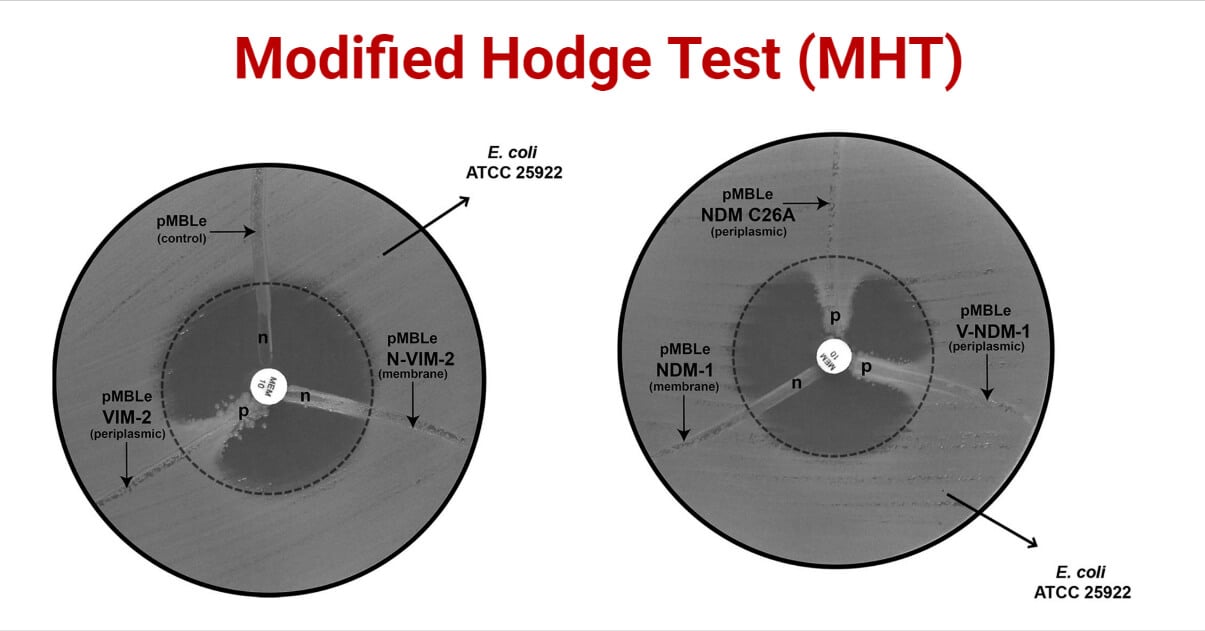Modified Hodge Test (MHT) is a phenotypic method for detecting carbapenemase production by isolated pathogens in clinical laboratories. It is a reliable method to confirm that the carbapenem resistance in the isolated bacterial pathogen is associated with carbapenemase production.
It was initially used for carbapenemase detection in Enterobacteriaceae for epidemiological or clinical purposes. But, it also found its use for carbapenemase detection in other suspected Gram-negative bacteria.
However, since 2018, the Clinical and Laboratory Standard Institute (CLSI) has labeled this as “No Longer Reliable Phenotypic Method For Carbapenemase Screening”, and has recommended using other tests like the CarbaNP test and mCIM test.
The requirements for this test are accessible easily and at a lower rate than other tests. Hence, several small clinical laboratories (mostly in developing countries) still use this test as a phenotypic method for detecting carbapenemase enzymes.
Interesting Science Videos
Objectives of Modified Hodge Test (MHT)
- To detect carbapenemase production.
- To detect whether the carbapenem resistance is due to carbapenemase production or other mechanisms.
Principle of Modified Hodge Test (MHT)
It is based on the principle that the carbapenemase enzyme produced by the test organism hydrolyses the carbapenem antibiotic resulting in the enhanced growth of carbapenem-susceptible E. coli.
If the test organism produces any carbapenemase enzyme, it will hydrolyze the diffused antibiotic in the vicinity of the streaked lines. This will enhance the growth of E. coli, which will otherwise be inhibited by the antibiotic, in the vicinity of the streak.
This growth enhancement results in indented growth of the E. coli and test organism within the zone of inhibition of the E. coli giving a clover leaf-like pattern.
Requirements for Modified Hodge Test (MHT)
- Carbapenem sensitive E. coli (E. coli ATCC 25922 strain)
- Mueller Hinton Agar (MHA) Plates
- Test bacteria
- Control Bacteria:
Positive Control: Klebsiella pneumoniae ATCC BAA – 1705 – MHT Positive
Negative Control: Klebsiella pneumoniae ATCC BAA – 1706 – MHT Negative
- Carbapenem antibiotic disc (10 mcg Etrapenem or Meropenem disc)
- Cotton swab or bent glass rod (Dolly rod) and inoculating loop
- Other general requirements like a Bunsen burner, sterile saline water (or broth), 0.5 McFarland standards, forceps, spirit, etc.
Procedure of Modified Hodge Test (MHT)
- Prepare a 0.5 McFarland standard suspension of E. coli ATCC 25922 (or E. coli strain sensitive to carbapenem)
- Dilute the suspension with sterile saline or broth in the ratio of 1:10 (add 0.5 mL of suspension at 4.5 mL of saline or broth)
- Uniformly streak or spread the diluted E. coli suspension on a sterile MHA plate (like during the usual antimicrobial sensitivity test) and allow it to dry for about 3 – 10 minutes.
- Place a disc of 10 mcg Meropenem or Etrapenem at the center of the inoculated MHA plate.
[Note: no more than one (1) disc is recommended for a 10 cm Petri-plate; and no more than four (4) discs are recommended for a 15 cm petri-plate by the CLSI]
- Using a sterile inoculating loop or swab, pick 3-5 colonies of freshly cultured test organisms and streak inside out in a straight line from the edge of the disc to the edge of the plate.
[Note: no more than one (1) test organism and two (2) control strains are recommended for 10 cm Petri-plate, and no more than six (6) test organism and two (2) control strains are recommended for 15 cm Petri-plate by the CLSI]
[The length of the streak must be at least 20 – 25 mm]
- Incubate the plate at 35(±2)°C for 16 – 24 hours at ambient air.
Observation of Modified Hodge Test (MHT)
Following the incubation, observe for the enhanced growth of the E. coli and formation of clover leaf-like indentation at the intersection of the streak of the test organism (and controls, if used) and the zone of inhibition of the E. coli.

Result Interpretation of Modified Hodge Test (MHT)
- Enhanced Growth (formation of clover leaf-like pattern) = Positive Result (carbapenemase production)
- No Enhanced Growth (no formation of clover leaf-like pattern) = Negative Result (No carbapenemase production)
K. pneumoniae ATCC BAA – 1705 will show enhanced growth of E. coli, forming a clover leaf-like pattern, while K. pneumoniae ATCC BAA – 1706 will not show enhanced growth of E. coli.
Advantages
- It is simple and easy to perform.
- Don’t require expensive resources. Hence can be implemented by smaller laboratories and institutes.
Limitations
- Organisms producing extended-spectrum β- lactamase enzymes (ESBLs) and AmpC β- lactamase enzymes give a false positive result.
- Some test organisms produce metabolites that inhibit the growth of E. coli
- Fails to detect all the carbapenemase production, hence often show false negative results (some researches show about 25 – 30% false negative results)
- Require longer incubation time.
References
- Amjad A, Mirza Ia, Abbasi S, Farwa U, Malik N, Zia F. Modified Hodge test: A simple and effective test for detection of carbapenemase production. Iran J Microbiol. 2011 Dec;3(4):189-93. PMID: 22530087; PMCID: PMC3330182.
- Modified Hodge Test for Carbapenemase detection: Principle, procedure (universe84a.com)
- _m100_archived_methods_table.pdf (clsi.org)
- Vanessa Bley Ribeiro, Adriano Rostirolla Linhares, Alexandre P. Zavascki, Afonso Luis Barth, “Performance of Quantification of Modified Hodge Test: An Evaluation with Klebsiella pneumoniae Carbapenemase-Producing Enterobacteriaceae Isolates”, BioMed Research International, vol. 2014, Article ID 139305, 6 pages, 2014. https://doi.org/10.1155/2014/139305
- Ghasemnejad A, Doudi M, Amirmozafari N. Evaluation of Modified Hodge Test as a Non-molecular Assay for Accurate Detection of KPC-producing Klebsiella pneumoniae. Pol J Microbiol. 2018;67(3):291-295. doi: 10.21307/pjm-2018-034. PMID: 30451445; PMCID: PMC7255689.
- Triton Hodge Test: Improved Protocol for Modified Hodge Test for Enhanced Detection of NDM and Other Carbapenemase Producers (asm.org)
